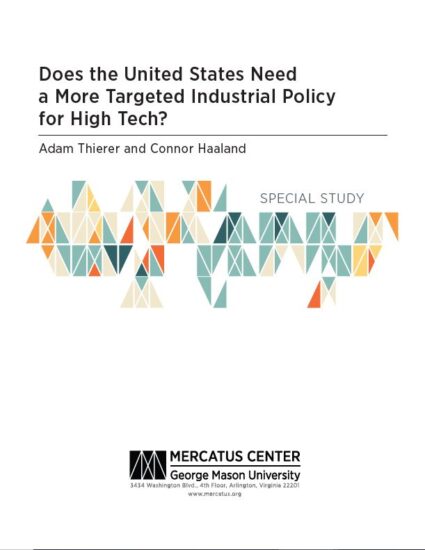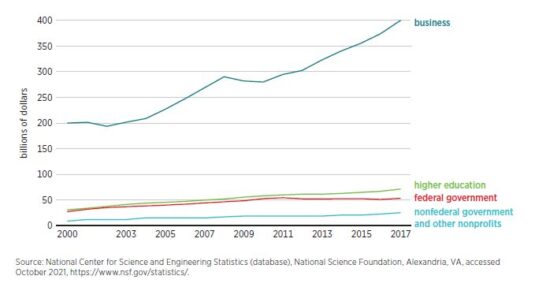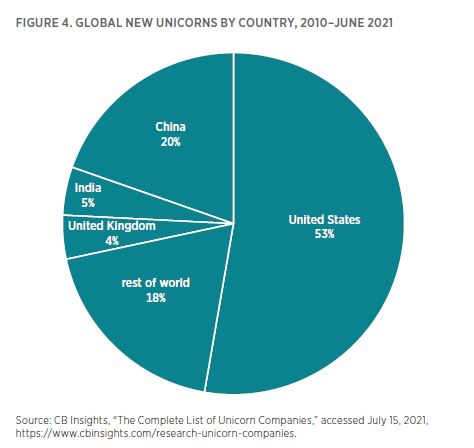 The Mercatus Center has just released a new special study that I co-authored with Connor Haaland entitled, “Does the United States Need a More Targeted Industrial Policy for High Tech?” With industrial policy reemerging as a major issue — and with Congress still debating a $250 billion, 2,400-page industrial policy bill — our report does a deep dive into the history various industrial policy efforts both here and abroad over the past half century. Our 64-page survey of the historical record leads us to conclude that, “targeted industrial policy programs cannot magically bring about innovation or economic growth, and government efforts to plan economies from the top down have never had an encouraging track record.”
The Mercatus Center has just released a new special study that I co-authored with Connor Haaland entitled, “Does the United States Need a More Targeted Industrial Policy for High Tech?” With industrial policy reemerging as a major issue — and with Congress still debating a $250 billion, 2,400-page industrial policy bill — our report does a deep dive into the history various industrial policy efforts both here and abroad over the past half century. Our 64-page survey of the historical record leads us to conclude that, “targeted industrial policy programs cannot magically bring about innovation or economic growth, and government efforts to plan economies from the top down have never had an encouraging track record.”
We zero in on the distinction between general versus targeted economic development efforts and argue that:
whether we are referring to federal, state, or local planning efforts—the more highly targeted development efforts typically involve many tradeoffs that are often not taken into consideration by industrial policy advocates. Downsides include government steering of public resources into unproductive endeavors, as well as more serious problems, such as cronyism and even corruption.
We also stress the need to more tightly define the term “industrial policy” to ensure rational evaluation is even possible. We argue that, “industrial policy has intentionality and directionality, which distinguishes it from science policy, innovation policy, and economic policy more generally.” We like the focus definition used by economist Nathaniel Lane, who defines industrial policy as “intentional political action meant to shift the industrial structure of an economy.”
Our report examines the so-called “Japan model” of industrial policy that was all the rage in intellectual circles a generation ago and then compares it to the Chinese and European industrial policy efforts of today, which many pundits claim that the US needs to mimic. We find problems with those models and argue that:
America’s goal should not be to “imitate China” or “copy its playbook” when it comes to targeted industrial policy and technological governance of AI and other high-tech sectors. Europe’s approach, although not as heavy-handed, is also not a good model. Not only would the Chinese and European approaches potentially undermine the permissionless innovation ethos that made America’s tech companies become global powerhouses, but expanded industrial policy efforts would entail massive state bets on risky ventures using taxpayer resources.
We discuss the public choice dynamics surrounding many industrial development efforts and note that, “what is often described as “industrial policy” is in reality nothing more than industrial politics.” We highlight how many of the largest industrial policy programs have been prone to highly inefficient contracting procedures and massive cost overruns. Sometimes outright corruption even becomes a problem with some of the largest programs. But that’s not the only cost. Sometimes, in their effort to promote specific industrial outputs or outcomes, government undermines the very innovation they hope to spur.
When governments repress the entrepreneurial spirit of their most innovative creators and companies, this is bound to have negative ramifications for long-term competitiveness and economic growth. Heavy-handed industrial policy schemes can contribute to this sort of repression as the state gains more levers of control over private companies.
We note how that has certainly been the case in the European Union, where “countries have adopted a highly precautionary regulatory model for new digital sectors that shuns risk-taking and focuses on maximizing other values at the expense of disruptive change. This approach has resulted in fewer national champions, and it has cost Europe in terms of global competitive advantage,” we note. We also highlight the long string of failed European industrial policy programs.
Ours is not a doctrinaire analysis; we take a pragmatic approach to the evaluation of industrial policy programs and proposals. Some of them may succeed based simply on the reality that “if government officials roll the proverbial industrial policy dice enough times, some bets are bound to pay off, at least indirectly.” But any serious analysis of these efforts, we argue, must fully weigh the trade-offs associated with the potential tax and compliance burdens associated with funding them to begin with.
But we admit that, “industrial policy will always be with us to some extent, given the sheer size of government and the many existing programs already devoted to economic development or high-tech initiatives.” Toward that end, we wrap up the paper with a variety of high-level recommendations about industrial policy. We highlight how:
The priority should be generalized economic development over targeted development efforts. The most important thing that policymakers can do to boost economic opportunities is to create a legal and regulatory environment that is conducive to entrepreneurship, investment, innovation, and free trade. [. . . ] government should focus on setting the table for entrepreneurial activity instead of trying to determine everything on the plate. To put this differently, policymakers need to avoid the “fun stuff” and focus on “boring” issues that often get neglected.
We apply these insights to the ongoing debate over regional economic development and the specific effort currently underway at the federal level to encourage “regional innovation hubs,” as federal and state lawmakers look to create “the next Silicon Valley” elsewhere.
In terms of our nation’s overall investment in R&D, we note that “[t]he United States has the most vibrant venture capital (VC) market in the world, and this market helps support risky ventures without gambling with taxpayer dollars.” While some bemoan the fact that private enterprise provides the bulk of R&D expenditures in the US – and that amount is increasing relative to governmental sources – this is actually something that should be celebrated. The strength of private-funded R&D helps set the US apart and make investment markets nimbler and more responsive to real-world needs. Moreover, global unicorn growth in the US continues at a healthy clip. From 2010 to mid-2021, the US created 53 percent of global unicorns, compared with 20 percent for China. These facts are often overlook in industrial policy debates.
While our paper is comprehensive, admittedly, there are some things we leave out of the analysis or do not spend as much time discussing. For example, there is a never-ending debate about the relationship between national security and industrial policy that raises many hard questions. A nation needs military hardware to defend itself, and almost every program to provide weapons and military equipment in the US involve private contracting to get them. These are the biggest industrial policy programs at all, but we don’t spend a lot of time focus on them in our paper because that would have taken us far afield.
We have a short section on these issues that notes how “defense-related programs have also been prone to highly inefficient contracting procedures and massive cost overruns.” Many of these programs remain vital, however, and must find a way to make them more efficient and cost-effective. But there are still other issues related to national security and industrial policy that raise hard questions, including: export or import controls, trade restrictions, and more. These continue to be challenging issues and I personally hope to revisit some of them in upcoming essays.
With Congress still trying to finalize its mega industrial policy bill, our paper is relevant to the short-term debate over these issues. But our hope is that this paper offers a big-picture, long-term framework for thinking through the challenges associated with industrial policy issues both here and abroad.
Here is the outline of the paper and, again, you can find it at this link. (The report can also be found on SSRN & Research Gate).
- Introduction: Definitional Challenges 5
- Calls for Expanding Industrial Policy to Boost High-Tech Innovation 8
- Some (Quickly Forgotten) Recent History 11
- The Romantic View of Industrial Policy vs. Reality 15
- The Challenge of Creating “National Champions”: Europe’s Failures 20
- Adverse Effects of State-Led Promotion: The China Model Examined 23
- Where Does Real Competitive Advantage Come From? 27
- Industrial Policy Did Not Give Us the Internet and the iPhone 33
- Evaluating Other Industrial Policy Efforts 39
- Using Competitions and Prizes to Encourage Innovation More Efficiently 46
- Conclusion: Generality Is Better Than Targeting
________________________________
Additional Reading:
- Adam Thierer, “Industrial Policy Advocates Should Learn from Don Lavoie,” Discourse, November 5, 2021.
- Adam Thierer, “Government Planning and Spending Won’t Replicate Silicon Valley,” Discourse, August 18, 2021.
- Adam Thierer, “To Promote Tech Hubs Across the Country, Governments Should Focus on Improving the General Business Environment,” Discourse, September 9, 2021.
- Adam Thierer, “‘Japan Inc.’ and Other Tales of Industrial Policy Apocalypse,” Discourse, June 28, 2021.
- Adam Thierer, “Industrial Policy as ‘Casino Economics‘,” The Hill, July 12, 2021.
- Adam Thierer & Connor Haaland, “Should the U.S. Copy China’s Industrial Policy?” Discourse, March 11, 2021.
- Connor Haaland & Adam Thierer, “Can European-Style Industrial Policies Create Tech Supremacy?” Discourse, February 11, 2021.
- Matthew D. Mitchell and Adam Thierer, “Industrial Policy is a Very Old, New Idea,” Discourse, April 6, 2021.
- Adam Thierer, “On Defining ‘Industrial Policy,’” Technology Liberation Front, September 3, 2020.
- Adam Thierer, “Skeptical Takes on Expansive Industrial Policy Efforts,” Technology Liberation Front, ongoing series.



 The Technology Liberation Front is the tech policy blog dedicated to keeping politicians' hands off the 'net and everything else related to technology.
The Technology Liberation Front is the tech policy blog dedicated to keeping politicians' hands off the 'net and everything else related to technology.